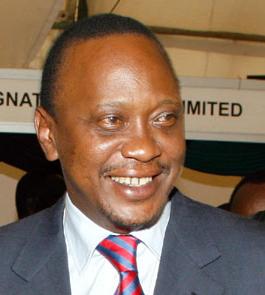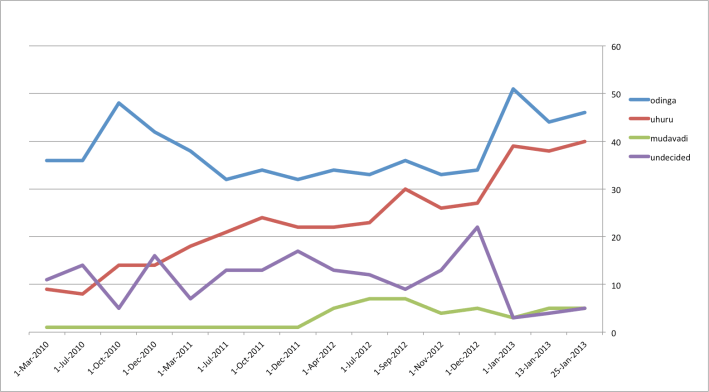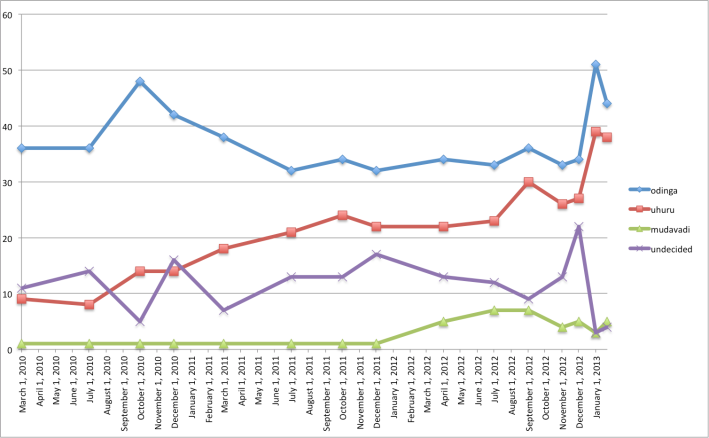Travel, conference and more travel have kept me from blogging in the last few days. I am back online. Kenyans go to the polls tomorrow. This is a post from a few days ago.
I am in New Haven (great to be back!) for a conference and visiting with friends before going back to Nairobi for Monday’s election and wanted to make a quick post on the latest in the upcoming Kenyan elections.
1. The Second Presidential Debate:
The second presidential debate was rather dull, to be honest.
The entire first half was supposed to be dedicated on the economy but mostly dwelt on the specific subject of corruption at the expense of other more pressing concerns like jobs and the modernization and formalization of the Kenyan economy (Not to trivialize Kenya’s obscene levels of corruption, but apparently the moderators do not read Blattman’s blog. The problem is huge, but there were other pressing economic issues that could have been addressed.)
The candidates were, as expected evasive over the matter – mostly giving vague answers to pointed questions on scandals they were rumored to have been involved in; from Goldenberg to Anglo Leasing to Maize to typos at the treasury.
The jester Candidate Dida provided a light moment when he asked the moderator if she expected thieves to admit that they had stolen.
The second half was better. It dealt with the issue of land. Again, no real answers emerged but it put Mr. Kenyatta – who’s family owns large tracts of land – on the hot seat. Land is an issue that has been the cause of ethnic clashes in every Kenyan election since 1992. Voters may just have got one more thing to think about before casting their votes on Monday.
Overall, I cannot say that any one candidate won the debate. However, Mr. Kenyatta lost a few points due to the amount of time spent on the land question. His main opponent Mr. Odinga even came to his rescue at one point, reminding viewers to cut Mr. Kenyatta some slack since he only inherited land that may have been dubiously appropriated by his father while he was president.
2. Election Day’s Big Unknown: TURNOUT
As I have pointed out before, the outcome of the presidential election in Kenya next Monday will hinge on turnout. Whether we shall wake up on March 5th with a president-elect or have to go for a runoff will depend on regional turnout rates.
As it is most public opinion polls point to a runoff.
However, the polls do not give us a sense of what proportion of registered voters are likely to vote.
One private poll that I have seen suggests that 98.3% of those polled said they would show up to vote. Such turnout numbers belong in Belarus. I expect average turnout to be between 75-85%.
Below is a table with the turnout rates in the last three presidential elections. (The 2007 figures should taken with a pinch of salt, for obvious reasons). As you can see history seems to be on Mr. Kenyatta’s side. Central Kenya and the Rift Valley, the two most populous regions of the country both support him overwhelmingly (according to the latest Ipsos Synovate poll) and have the highest average historical turnout rates.
| Region/Turnout |
1997 |
2002 |
2007 |
|
Kenyatta Support |
Odinga Support |
| Central |
74.1 |
66.1 |
82.1 |
|
88.1 |
6.4 |
| Rift Valley |
75.9 |
60.8 |
72.8 |
|
69 |
23.3 |
| Eastern |
72.6 |
60.9 |
65.9 |
|
41.8 |
52.7 |
| Nyanza |
67.2 |
55.6 |
76.2 |
|
9.8 |
83.8 |
| Western |
68.1 |
57.1 |
62 |
|
3.4 |
53.6 |
| North Eastern |
55.9 |
57.8 |
61.3 |
|
37.9 |
44.1 |
| Coast |
50.6 |
42.1 |
57 |
|
18.3 |
73 |
| Nairobi |
50.2 |
42 |
51.5 |
|
39.6 |
51.9 |
Could turnout rates be different this time?
The answer is maybe, due to the following new variables:
- New positions created in the constitution – governor, senator, and women rep – might attract new voters in addition to those who have in the past voted for the three other posts – president, MP and councillor (now county rep). This might increase turnout across the board, but since Mr. Kenyatta is already “maxing” his turnout rates Odinga might benefit from an overall increase in turnout rates.
- The dropping of calls for “six piece” vote. Earlier in the cycle both candidates had insisted that voters should vote one straight ticket for the party for all six posts. However, since the nominations for both leading parties/coalitions were a total mess many popular candidates did not get nominated on the “right parties.” Insisting on a six piece vote would have lowered turnout. However, without it everyone has a candidate to vote for in their preferred presidential candidate’s stronghold. This may increase turnout since it gives incentive for say someone running in an Odinga stronghold, who supports Odinga, but is not in Odinga’s party to still mobilize his supporters to the polls in competition with the candidate in Odinga’s party. Again, a higher average turnout rate will benefit Mr. Odinga.
3. The Numbers:
The last polls before the election (about five of them) show a slim national lead for Mr. Odinga over Mr. Kenyatta, 45% to 43% on average. But since we do not know the make up of likely voters I would be reluctant to declare Mr. Odinga a favorite going into Monday. Mr. Kenyatta’s strongholds have historically had better turnout rates than Mr. Odinga’s.
And on the matter of polls, the following factors may lead to surprises on Monday night:
- Desirability biases in the survey: We do not know to what extent those interviewed lied about who they support. And on this count Mr. Kenyatta runs the highest risk. Because of the ICC cases he and his running mate face, many higher income and educated Kenyans have had concerns about their ability to run the country “via Skype.” If such people residing in the Rift Valley and Central regions lied to pollsters because they were expected to like Kenyatta then we may be in for a surprise on Monday night. If Mr. Odinga gets more than 35% of the votes in Rift Valley and about 15% in Central Kenya he will win the presidential election in the first round.
- Strategic voting: One of Mr. Odinga’s many challenges has been the Western Kenya region where Musalia Mudavadi comes from. Mr. Mudavadi is the third candidate, getting 6% on most polls nationally and about 34% in Western region. Mr. Odinga gets 53% in the region and Kenyatta 3%. In the event of a runoff, most of Mudavadi’s voters will break for Odinga. Mr. Mudavadi’s candidature centres on becoming a King maker and elevating his stature as a serious contender in the next elections (2017). But if Western voters who would support Odinga in the second round decide to do so in the first round Odinga will have an outright victory in the first round.
Barring any surprises on Monday (esp with regard to turnout) the state of play is that the first round will be a close contest between Kenyatta and Odinga, with one or two percentage points separating them.
Mr. Kenyatta is a slight favorite to win the first round, but will be short of the 50% required for an outright win. In the second round, however, I expect Mr. Odinga to be a clear frontrunner since most of Mudavadi’s voters in Western Kenya will break for him. I also expect a little bit of anti-Ruto (Kenyatta’s running mate) votes in the Rift Valley going to Mr. Odinga. I am very curious as to what President Moi’s promised major announcement on March 5th will be…. perhaps an endorsement?
All in all I would put my money on Mr. Odinga becoming Kenya’s fourth president.
 2. The number electoral units (wards or constituencies) had no influence on the rate of voter registration in the 47 counties. In other words, it is not the case that counties which had a lot more electoral units (and therefore potential candidates) experienced greater rates of voter mobilization for registration.
2. The number electoral units (wards or constituencies) had no influence on the rate of voter registration in the 47 counties. In other words, it is not the case that counties which had a lot more electoral units (and therefore potential candidates) experienced greater rates of voter mobilization for registration. 3. However, the population per electoral unit (wards and constituencies) was negatively correlated with the registration rate. In other words, more populous wards and constituencies experienced lower registration rates relative to their less populous counterparts. This makes sense, to the extent that the IEBC was targeting a specific number of BVR kits per electoral unit per county.
3. However, the population per electoral unit (wards and constituencies) was negatively correlated with the registration rate. In other words, more populous wards and constituencies experienced lower registration rates relative to their less populous counterparts. This makes sense, to the extent that the IEBC was targeting a specific number of BVR kits per electoral unit per county. 4. Bigger counties with relatively smaller populations benefited from the fact that land area was a consideration in IEBC’s allocation of BVR kits.
4. Bigger counties with relatively smaller populations benefited from the fact that land area was a consideration in IEBC’s allocation of BVR kits.










